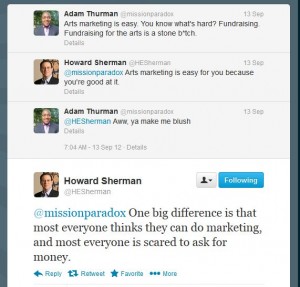Apparently Netflix Powerpoint presentation on human resources has been getting a lot of views this last month. I remember being able to read the accompanying article on Harvard Business Review at one time, but it seems to be protected by a registration requirement now.
The Powerpoint presentation can be viewed however and has some interesting lessons about employee relations for non-profit arts organizations. I will state outright that probably the biggest hurdle for arts organizations will be paying top dollar for top talent since the arts are often limited in their earning ability. However, given that arts people are often motivated by psychic income rather than monetary income, some of Netflix basic philosophy may apply.
Or perhaps having highly talented people working for you and following their ideas about jettisoning process and procedure can help you identify income streams needed to provide appropriate remuneration.
There are 126 slides so I can’t really summarize the whole presentation, but I wanted to talk about a few that stuck out.
Slides 4-18 talk about the values of Netflix making it clear that their view is that the true values of any company aren’t what they say they value on paper, but what employee activities are actually rewarded. A company says they value integrity, but punish a whistleblower, then that is not a true company value.
This is something to think about when writing your organizational values and mission statement. It almost seems best to be like the college campus that only puts in sidewalks when they see where the students walk to get between buildings. It might be best to enumerate the values you do exhibit rather than the ones you aspire to–and then revise as you evince more constructive behavior.
The thing about Netflix HR policy that most companies might have a hard time implementing is in slide 22. “Adequate performance gets a generous severance package.” They want people who are performing at their best and give those who aren’t the boot, but in the nicest way possible.
In the article which is now behind a registration system, they talk about a woman who was a great producer, but as technological advances left her behind, she couldn’t conform so they sat her down. They make it sound like she was relived to be let go (and maybe the severance package is just that good).
It seems a little cold hearted, but it does show they are in earnest when they claim a commitment to only working with the top talent they can find. In the slides that follow, they talk more about that, saying they use the metric of who would they fight to keep if the person was being hired away. You keep those you would fight for and give severance to everyone else.
To be fair, they say the approach should go the other way (slide 27) and that every employee should periodically ask what their manager would do to keep them on if they gave their two weeks. Later in the slides, they say that interviewing with other firms while working for Netflix is not a sign of disloyalty, but a good way to discover your market value, just make sure you don’t reveal any corporate secrets. (slide 108)
In slide 38, they admit working for them is not for everyone. They focus on results, so you don’t get an A for effort.
Where things get interesting is around slide 43. This is where they talk about why they are so focused on only keeping the most talented people. They note how companies often start curtailing freedom as they get bigger and more complex. Companies will add processes, but Netflix says that is only a short term solution because they lose their ability to be flexible (slide 51-61) in the face of change.
The solution is to increase the level of talent in your organization faster than complexity, that way you have self-disciplined, creative people working for you who don’t require tons of processes to keep them reined in.
This is the part I felt was most applicable to the arts. The conversation these days focuses on how inflexible arts organizations are at responding to the changing operating environment. Yet we have some of the most talented, creative people working for us. Small arts groups are nimble, but as they grow and become established, they generally seem to become less flexible. The size and desire for job stability by the employees has frequently been identified as prime culprits.
But according to Netflix you can have growth, organizational flexibility and job stability, so perhaps it is the processes that are to blame.
The next slide was the one that intrigued me most:

That last line implying it is better to be flexible enough to recover from a problem rather than having rules to prevent them really caught me off guard. And in the slides that follow (63-71) they give examples of good and bad processes and discuss how their famous “take whatever vacation time you want” policy came into being. (Slide 67 is essentially the thesis)
But the idea that it is better for creative environments to take errors in stride and move past them echoes the oft expressed idea that artists and arts organizations shouldn’t fear making mistakes and taking risks because it is integral to self-development.
There are some interesting slides on employee relations, providing context rather than attempting to control (81-87). I don’t want to get into summarizing that because I wanted to tackle their compensation policy.
Their philosophy is that the compensation for each person is individual and they should be paying top market price for that person. And that they shouldn’t wait until an annual review to award an increase in compensation if they realize they are not paying top dollar, they should do so immediately.
Compensation is not dependent on Netflix success. (96-104) They are against giving raises based on job title (what are all other marketing directors getting? Not all people with that title are of the same quality), or giving across the board percentage raises, or practicing internal parity (everyone in the department/seniority get paid the same).
For Netflix, monetary compensation is everything. I imagine that is because they are hiring people who are both very talented and motivated by the idea monetary compensation is everything.
For arts organizations, it is probably possible with some thought to find non-monetary rewards that motivate employees along the same philosophical lines utilized by Netflix. Perhaps flex time, access to facilities and supplies to exercise their creativity, use of organization owned housing for out of town guests at Christmas, etc.
Given the idea that compensation level is personal to each individual, the opportunities provided to each person may be different. An administrator and a receptionist may end up making the same salary because the administrator values being able to use the ceramic studio to create works they can sell over being paid more.
If you subscribe to their philosophy that A level results for B level effort gains you greater responsibility and compensation that will allow you to grow within the company, then a receptionist who has made great contributions could be promoted to the marketing department.
But then you potentially run into the area that takes the most courage–letting go of a mediocre producer in the marketing department. If there are a couple of stars in the marketing department who have the potential of heading up a new endeavor that will earn more revenue, that’s great, shuffle them off to better things. But you might as easily need to let someone go to get the best talent into marketing.
Netflix philosophy assumes everyone working for them is motivated to advance. I don’t recall if they covered this in the slides or the article, but I suspect if someone declined to be promoted, they might be viewed as too timid for the company’s ambitions and content to invest B effort to generate A work.
This may be just as true for an employee of an arts organization, but much more difficult to discern because the person could value the work/life balance afforded by their position so they can spend time with family or artistic pursuits. You might never find someone who can produce as well as they can working 25 hours a week and they may stick with you for the next 10 years. It can be tougher to discern in the arts and tougher to find the resolve to cut mediocre people loose.
But I suppose allowing for employee work-life balance is why Netflix has the very liberal “no-vacation policy” vacation policy. They probably understand that those needs are just as individual as compensation.






I've been to a few of the Science on Tap events, though I never gave a talk at one of…